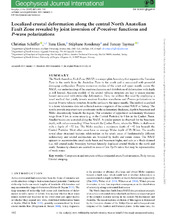Localized crustal deformation along the central North Anatolian Fault Zone revealed by joint inversion of P-receiver functions and P-wave polarizations
Peer reviewed, Journal article
Published version

Åpne
Permanent lenke
https://hdl.handle.net/1956/22411Utgivelsesdato
2019Metadata
Vis full innførselSamlinger
- Department of Earth Science [1050]
Originalversjon
https://doi.org/10.1093/gji/ggz040Sammendrag
The North Anatolian Fault Zone (NAFZ) is a major plate boundary that separates the Eurasian Plate to the north from the Anatolian Plate to the south and is associated with powerful damaging earthquakes. Despite numerous studies of the crust and upper mantle across the NAFZ, our understanding of the exact mechanisms and distribution of deformation with depth is still limited. Accurate models of the crustal velocity structure are key to assess seismic hazard associated with strike-slip deformation. Here, we address this need by employing a novel method that jointly inverts receiver function waveforms and P-wave polarizations to recover S-wave velocity structure from the surface to the upper mantle. The method is applied to a dense teleseismic data set collected across a segment of the central NAFZ in Turkey. The results provide important new constraints on the sedimentary thickness, depth to basement and Moho discontinuity beneath the region. Our estimates of uppermost sedimentary thickness range from 0 km in some areas (e.g. in the Central Pontides) to 6 km in the Çankırı Basin. Smaller basins are scattered along the NAFZ. A similar pattern is observed for the basement depth, with values exceeding 10 km beneath the Çankırı Basin, where the Moho is shallowest with a depth of ∼32 km. The Moho reaches a maximum depth of ∼42 km beneath the Central Pontides. Most other areas have an average Moho depth of 35–38 km. The results reveal clear structural–tectonic relationships in the crust: areas of fundamentally different sedimentary and crustal architecture are bounded by faults and suture zones. The NAFZ appears to accommodate small-scale basin and basement-highs, and acts as a thick-skinned (i.e. full crustal-scale) boundary between laterally displaced crustal blocks to the north and south. Seismicity clusters are centred on areas of low Vp/Vs ratios that may be representative of weak zones.